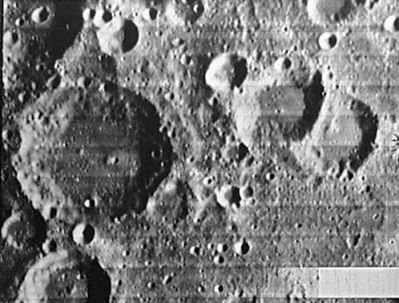Difference between revisions of "Baco"
(Created page with "<div id="content_view" class="wiki" style="display: block"> =Baco= {| class="wiki_table" | Lat: 51.0°S, Long: 19.1°E, Diam: 69 km, Depth: 2.49 km, [/R%C3%BCkl%2074 Rükl...") |
|||
| Line 26: | Line 26: | ||
[http://en.wikipedia.org/wiki/Roger_Bacon Roger Bacon] (c. 1214–1294), was a British natural philosopher and optician who placed considerable emphasis on empiricism and was one of the earliest European advocates of the modern scientific method. Bacon possessed one of the most commanding intellects of his age, or perhaps of any, and, notwithstanding all the disadvantages and discouragements to which he was subjected, made many discoveries, and came near to many others. His ''Opus Majus'' contains treatments of mathematics and optics, alchemy and the manufacture of gunpowder, the positions and sizes of the celestial bodies, and anticipates later inventions such as microscopes, telescopes, spectacles, flying machines, hydraulics and steam ships. He first recognized the visible spectrum in a glass of water, four centuries before Sir Isaac Newton discovered that prisms could disassemble and reassemble white light.<br /> <br /> | [http://en.wikipedia.org/wiki/Roger_Bacon Roger Bacon] (c. 1214–1294), was a British natural philosopher and optician who placed considerable emphasis on empiricism and was one of the earliest European advocates of the modern scientific method. Bacon possessed one of the most commanding intellects of his age, or perhaps of any, and, notwithstanding all the disadvantages and discouragements to which he was subjected, made many discoveries, and came near to many others. His ''Opus Majus'' contains treatments of mathematics and optics, alchemy and the manufacture of gunpowder, the positions and sizes of the celestial bodies, and anticipates later inventions such as microscopes, telescopes, spectacles, flying machines, hydraulics and steam ships. He first recognized the visible spectrum in a glass of water, four centuries before Sir Isaac Newton discovered that prisms could disassemble and reassemble white light.<br /> <br /> | ||
==LPOD Articles== | ==LPOD Articles== | ||
| − | [http:// | + | [http://www2.lpod.org/wiki/August_18,_2007 Texturous Terrain]<br /> <br /> |
==Lunar 100== | ==Lunar 100== | ||
[/Lunar%20100 L55]: Unusually smooth crater floor & surrounding plains.<br /> <br /> | [/Lunar%20100 L55]: Unusually smooth crater floor & surrounding plains.<br /> <br /> | ||
Revision as of 19:09, 11 April 2018
Contents
Baco
|
Lat: 51.0°S, Long: 19.1°E, Diam: 69 km, Depth: 2.49 km, [/R%C3%BCkl%2074 Rükl: 74] |
Table of Contents

LOIV 095 H1, Baco is on the left, [/Ideler Ideler] is the left-hand crater of the pair on the right.
Images
LPOD Photo Gallery Lunar Orbiter Images Apollo Images
Maps
(LAC zone 127A2) LAC map Geologic map
Description
Description: Elger
([/IAU%20Directions IAU Directions]) BACON.--A very fine ring-plain, 40 miles in diameter, S.E. of [/Clairaut Clairaut]. At one peak on the W. the terraced wall rises to nearly 14,000 feet above the interior. It is broken on the S. by three or four craters. On the E. there is an irregular inconspicuous enclosure, whose contiguity has apparently modified the shape of the border. There are two large rings on the N. (the more westerly having a central peak), and a third on the W. The floor appears to be devoid of prominent detail.
Description: Wikipedia
Additional Information
Data from [/Kurt%20Fisher%20crater%20depths Kurt Fisher crater depths]
- Westfall, 2000: 2.49 km
- Viscardy, 1985: 3.9 km
Nomenclature
Roger Bacon (c. 1214–1294), was a British natural philosopher and optician who placed considerable emphasis on empiricism and was one of the earliest European advocates of the modern scientific method. Bacon possessed one of the most commanding intellects of his age, or perhaps of any, and, notwithstanding all the disadvantages and discouragements to which he was subjected, made many discoveries, and came near to many others. His Opus Majus contains treatments of mathematics and optics, alchemy and the manufacture of gunpowder, the positions and sizes of the celestial bodies, and anticipates later inventions such as microscopes, telescopes, spectacles, flying machines, hydraulics and steam ships. He first recognized the visible spectrum in a glass of water, four centuries before Sir Isaac Newton discovered that prisms could disassemble and reassemble white light.
LPOD Articles
Lunar 100
[/Lunar%20100 L55]: Unusually smooth crater floor & surrounding plains.
Bibliography
Wood, C.A. 3/2006. Looking between Craters. S&T 111(3):58
This page has been edited 1 times. The last modification was made by - tychocrater tychocrater on Jun 13, 2009 3:24 pm - afx3u2